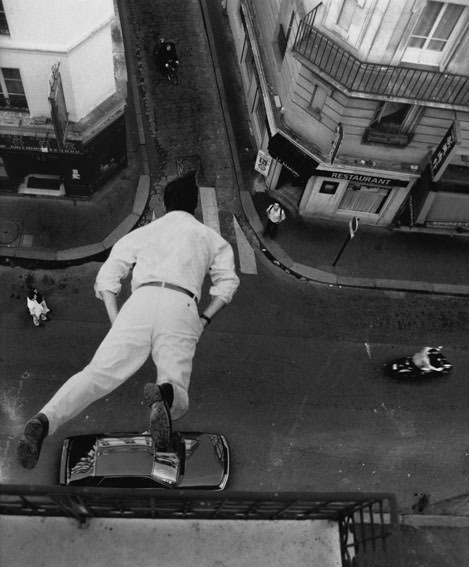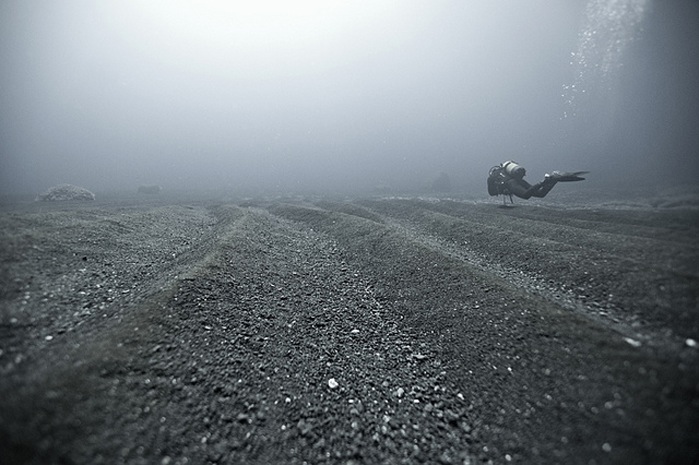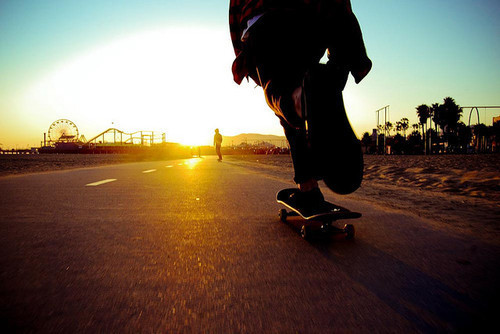
Experience Torn to Shreds/Experiments From the Granary by Mike Cartmell (1992)
…two world wars, totalitarianisms of the right and left, massacres, genocides, and the Holocaust—have already signified (if one can still speak meaningfully) an experience torn to shreds, one impossible to put back together. It also points out the failure of the “I think”… doing its utmost, to reassemble the fantastic images of the real into a world. A defeat experienced not so much as a contradiction or failure of philosophical audacity, but already, as a cosmic catastrophe, like that mentioned in Psalm 82.5: “All foundations of the earth are shaken.” Emmanuel Levinas
dream delivers us to dream
As in a dream, I remember one warm summer night in Chicago, a few years ago. It was near dark, Vincent Grenier and I sat on his porch drinking a beer and chatting. And through the gaps between the buildings in front of us could be seen heard felt a large urban intersection, the confluence of several busy streets, the frequent blare of car horns and vocal chords, the palpable swelter of city heat. (I give these details in hopes of delivering to the reader an oneiric picture.) Slung crazily on the façade of a bank, an electronic sign blipped its version of time and temperature, each serenely inaccurate. The sign then, and its memory now, put me in mid of Lacan’s account of a similar scene in 1966, his description of Baltimore in the early morning as “the best image to sum up the unconscious.” During our conversation, Vincent told me of his admiration for Claude Lanzmann’s Shoah, and the importance it holds for his own work.
that cryptic might
Testament of fracture, fractured testimony; fragments of witnessing and the bearing of witness. I invoke this picture that it might lie, encrypted, in the back of the reading I take here, and that it might come to animate (privately, secretly) that difficult circulation between viewers and films that we can call a cinematic reading (vision, but also scrutiny; hearing, but also listening: to witness.) A reading which, in Blanchot’s words, “is anguish, and this is because any text, however important, or amusing, or interesting it may be (and the more engaging it seems to be), is empty—at bottom it doesn’t exist; you have to cross an abyss, and if you do not jump, you do not comprehend.” And with anguish, a certain grief.
I grieve that grief can teach me nothing
But it is the process that is crucial. Precisely the experience, it we understand this word etymologically as trial or test, a perilous crossing. Grenier’s films experiment with the experience of others, their difficult acts of memory or let us say, remembering; gathering together the errant fragments of something that was, that will not be again, and rearticulating them (that is, in speech) as members of something else, something that is. Or better, that will be.
the capital exception
I will say that the singularity of Grenier’s approach lies first in its refusal to accord any transparency to the presentations of the speakers, or to the cinematic (re)presentations of their speech. For the making of these films is also a rearticulation, a speaking of experience; and the same sorts of obscurely potent and embedded particularities that make, for each one of us, the peculiar drift of our speaking peculiarity our own, constrain the maker too, and so the work. The second mark of exception would be that these complications pertain to the experience of the viewer as well.
I do not make it; I arrive there
So that the notion of the maker as intentional, deliberate, mastering comes to be tempered (at the very least) by the perils (accidental, spontaneous, unmasterable) of his own experience. (I think of Lacan’s account of his theoretical procedure in Seminar XI: “I do not seek, I find.”) What’s available is gathered up, put to the test, subjected to experiment by one who is himself in process, on trial. (Perhaps he could say, with Melville’s Ishmael: “I am the architect, not the builder.”) And the work takes shape, and shape again in the shaping of each viewer who risks a leap.
In this our talking America
They are talking, everywhere and always, about loss. In I.D. Joanne has lost her job (perhaps her dignity); Milton’s parents have lost their home and possessions, and he his breath; Steve recounts Harpo’s death (and where is his brother Sean?); Gayle talks about the Prisoner who has lost his name. Lisa’s story in You is of a failed love affair, and Dan in Out in the Garden has lost his future. What is remarkable is the powerful passivity with which they speak in the face of loss, the passion not only of what they say, but of how they say it, how they behave as they speak. They all perform a labor, let’s say a work of mourning. The losses of which they speak amount finally to loss of self, and this labor of speaking, this coming to terms with loss becomes an effort to find oneself again, to remember oneself.
where do we find ourselves?
Precisely at a loss, and everywhere and always. Every recovery from loss is a gathering, through speech, of those scattered remnants which happen to hand, and which we sort through (as if to separate kernel from husk) and piece together as experience in which we find ourselves again, and anew. But every new experience of self risks new perils, and the price of recovery of self is the inevitable need to recover it again. The question “who am I?” can (must) only be answered again and again, and only partially, in fragments. Every finding of an answer entails its failure, and the question must be broached anew in a speaking (we could say, dialectic) that is not terminable.
All our blows glance, all our hits are accidents
I come back to Grenier’s approach. Blows (I mean the way the maker approaches) glance because they are observations, they bear witness. Hits (I mean the character of the observations, the cinematic articulation) are accidents because they are not essences. He finds what comes to hand, picks it up, uses it in his own (peculiar, particular) way. Take the amazing segment from Out in the Garden in which Dan’s face as he talks is reflected in (in a way, superimposed upon) a framed photograph that seems to be several decades old. The man depicted could be Dan’s father or grandfather, but he’s young in the photograph, younger than Dan, wears a collar and tie and a confident, maybe even smug, expression. Dan is speaking about being HIV positive, about how concerned people are, about the pity he reads in straight people’s faces, how they seem to confer a death warrant upon him, how he wishes they weren’t so concerned. His face (its reflection) is distorted by the imperfections of the glass in the photo frame. Sometimes the two faces seem to merge into a composite, sometimes one or the other grasps our attention. A stunning range of oppositions is set up: youth/middle-age; confidence as to the future/hopelessness in the lack of a future; a movement, in the past, toward the future (to be experienced)/a movement, in the present (now past) toward the past in search of experience (to be remembered, to be missed): paternity, engenderment, generation/filiation, non-engenderment, end of generation; straight/gay; clarity/distortion. (I am not being exhaustive.) All of this can be found in the found image/segment, but it founds no essential or immanent meaning. It can be given (it gives itself) only and precisely to be read, and meaning can be conferred upon it only retroactively (and only inconclusively).
everything looks real and angular
This process (trial, test, experiment) of approach by indirection, as if taking an (accidental, not deliberate) angle on things, is relentless in these films. Dan almost never speaks on camera directly; Instead we see him hear him through a window which reflects the bare branches of a tree, as a shadow on a patio, in a mirror, and so on. In I.D., Gayle speaks off-camera in the Prologue, Nadra is caught in extreme close-up (her hands, the back of her head), Steve is reflected in a mirror (or his reflection is blacked by his interlocutor). Milton talking about his parents is superimposed on Milton talking about his asthma attack, the two soundtracks competing for dominance. All of this angularity, this indirection requires that some direction through (let’s say, across) the film has to be found by the viewer in his or her own way, should that way be risked.
Like a bird which alights from nowhere
So many oddities of Grenier’s mode of cinematic articulation (call it a language, a way of speaking: I continue to insist) simply invite us to be struck (not a glancing blow, a hit!); I mean impressed, moved. In You, what seems to be a double image of Lisa swims and glitters on the surface of some ocean, as she tells the story of the Porsche driver with the baseball bat. Suddenly, as if from nowhere, a stick emerges from the bottom of the image, and then two feet. The stick stirs the water and we have to rethink (re-experience?) what we’ve just seen (and what we’ve just heard?), and work out (is it possible?) what we’ve witnessed. Find something, lose it, refind (passively, passionately) something new again.
we thrive by casualties
Pushing this a bit further, this stunning double reflection of Lisa I mean, we can see (from this distance, retroactively, that is) how casually apt it is. There are two reflections, and there are two Lisas: she speaks (she remembers) and she writes (we know not what): there is Lisa now (she is speaking) and Lisa then (she is spoken). The displacement at work here is extensive: Lisa now (speaking) is Lisa then (being filmed) but also Lisa as she will always be (on film); but Lisa on film will never be apprehended fully the same way twice by any viewer. (The potential for vertigo is immense in trying to think this through.) Also doubled is the “you” to whom Lisa speaks, who is presumably her real ex-lover, but whose position, because of the pronoun, the viewer can’t avoid taking up to some extent. And with that identification comes the threatening aggressivity in Lisa’s address.
these beautiful limits
At the beginning of You, Lisa talks about her fear of going to the movies with “you” because of the danger of one of “your” excessive responses to people talking during the film. We see her partially hidden behind a large shaft that’s part of some sort of machinery, the cogs and wheels of which, and the flickering light in which it’s bathed, are suggestive of a movie projector. You (I mean you the viewer) are in fact at the movies, watching this film. Maybe somebody’s talking rudely nearby. Maybe you’d like to take a swipe at him. There are plenty of invitations in the film (and in the others) for identification, but also plenty of operations (non-synchronous sound, rapid cutting, bizarre images, aggressivity) which undermine it. What is crucial in these films that stress the absolute particularity (I’d even say the potential unintelligibility) of a person’s experience (and his or her means of speaking it) is their profound openness to the relation of interchange between viewer and film, identification will frequently be gratified but just as frequently blocked; the viewer can suffer (as a passion, I’ll say) this blockage, will experience it as a loss, and can be changed by it; and the viewer can then return to the film to find a different articulation of the blockage or passage of identification in a process (trial, experiment, experience) potentially interminable. A dialectic, that is, which, in its itinerant circulation around the question of identity, exerts upon it (for viewer and maker both, I’d say) a destabilizing force.
we have not arrived at a wall, but an interminable oceans
Or, we must say with Blanchot, at “that marine infinitude which both buoys and engulfs.” We are lost, we capsize, we meet the limit which would sublimely overwhelm us, but find ourselves anew again, recovered on board the devious-cruising bark of experience newly remembered: passage for another risky crossing.
I know better than to claim any completeness for my picture
In these remarks I’ve privileged Grenier’s most recent films, his “talking pictures.” While I’d be unwilling to propose any developmental saga, I can (sketchily) suggest some features of the early work that are pertinent to the late. The delicate luminous illusions tested in While Revolved and Closer Outside resurface in I.D. and You, reflecting the illusory identities at stake there. Interieur Interiours sets up a kind of feminine topology (of the fold, say: a kind of chiastic crossover of inside with outside), a spatial erotics resonant with Lisa’s doubled (maybe inverted) image in You, and with the use of superimposition in I.D. World in Focus opposes mapping, the finding of direction, to indirection (focal articulation), and suggests, through its investigation of the book, that finding oneself, one’s place, has something to do with reading. More generally, the early films exhibit (uncannily) the uncanny domesticity so crucial to the later work.
ghostlike we glide
D’Apres Meg foregrounds the uniqueness of human gestures as a pre-verbal mode of expression (call it a speaking). And I will say that Time’s Wake (Once Removed) marks the transition to the “talkies” in its shifting from the domestic to the familiar (the family, but also the sense of ghostly companion: it is that sort of wake too). Composed of fragments of what seem to be “home movies”, and using many of the formal elements of the work that succeeds it, Time’s Wake, despite its silence, establishes a (ghostly) discourse inexorable and mournful in its drift as the icepack in the St. Laurence.
I am a fragment, and this is a fragment of me
I cannot apologize for the personal, peculiar (not to say perverse) character of my remarks. My account has been of the work of my friend, my Vincent Grenier, as I experience, as I think and speak it and him. If has no authority but my meager own. If I have (perhaps unfashionably nowadays) made him Emersonian, it is because I read him as sharing the complex and ethical approach of Emerson’s “Experience” to “this new yet unapproachable America.” This approach, this experience (experiment), is mournful and recuperative and renewing; it is torn, in fragments; it shakes the foundations of the earth. (I could have spoken of its mystical character, risking everything.) It is nothing without its peril. Somebody’s always liable to come after you with a baseball bat.
we live amid surfaces, and the true art of life is to skate well on them
If Vincent has a Hitchcockian cameo in his films, it can only be the masked and crazylimbed skater in D’Après Meg.
we dress our garden
So many gardeners in these films: Meg, Milton, Dan; even Lisa tends a watery garden. A familiar (uncanny?) metaphor: Eden, America. A garden could also be a cemetery, or that wild growth that overruns the site where a concentration camp used to stand. We dig and dress, we prune and tend and cultivate; or we simply stand and mark the place, observing the grasses and wildflowers and the few remaining broken scorched bricks. Tending, attendance; a labor, a duty. And sometimes we can, as Vincent Grenier can, stoop down and separate the corn from the dross, gather it up and store it in the granary. Our sustenance over a hard winter. Our seed for spring.
“Simulacra: The End of the World” (tr. David Allison) in David Wood (ed.) Writing the Future London: Routledge, 1990 p. 12.
“Of Structure as an inmixing of Otherness Prerequisite to Any Subject Whatever” in Donato and Mackey (eds.) The Structuralist Controversy Baltimore: Johns Hopkins University Press, 1970 p.189.
The Writing of the Disaster (tr. Ann Smack) Lincoln: University of Nebraska Press, 1986 p10.
The Four Fundamental Concepts of Psychoanalysis (ed. J-A Miller)(tr. Alan Sheridan) New York: W W Norton & Co., 1977 p. 7
The Writing of the Disaster p. 112.
The boldface headings of each of these paragraphs are extracted from Emerson’s essay.





